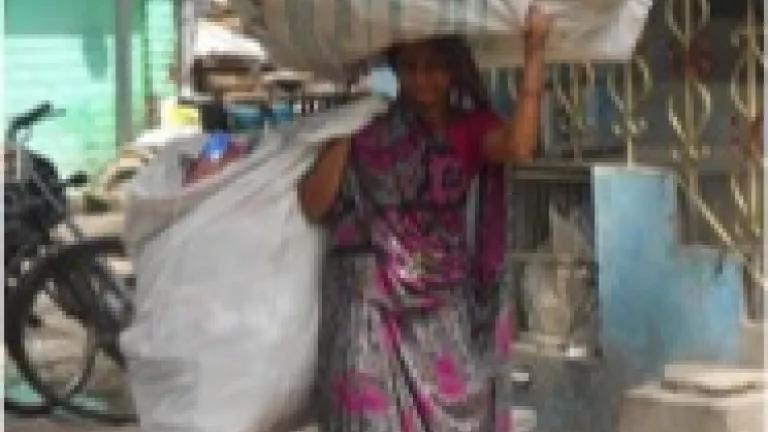Guest Blog: Ahmedabad, India's Urban Poor Hit Hard by Heat Waves, with Women on the Frontlines

Guest Blog by Zahir G Shaikh, IIPH(G)-CEPT University, Ahmedabad
Due to climate change, rising temperatures are expected to keep heating up a typically scorching summer season in fast-growing Ahmedabad, India – making a focus on identifying the city’s most vulnerable populations crucial to protect those at-risk residents. As a researcher at the Indian Institute of Public Health-Gandhinagar (IIPH(G)), I assessed these vulnerable communities in Ahmedabad and found that the city’s urban poor women are disproportionately affected by increasingly severe heat waves. As global warming fuels hotter temperatures year after year, ensuring that outreach and protection measures are tailored to reach Ahmedabad’s most vulnerable communities, including urban poor women, is key to reducing heat-related deaths and health issues.
Member of female waste pickers group carrying almost 15 kg of waste sacks on the streets of Gomtipur in Ahmedabad in May 2013. Photo by Zahir Shaikh.
In Ahmedabad, the summer season usually starts in March and lasts until the monsoon sets in around mid-June. A devastating heat wave in 2010 resulting in hundreds of deaths across Ahmedabad spurred the local government, the Ahmedabad Municipal Corporation (AMC), into action to protect its residents. Teaming up with a coalition of partners including among others, IIPH-G, and NRDC, the team created and implemented the city’s first Heat Action Plan in India last year, which included an early warning system and preparation and outreach measures to keep vulnerable communities safe during extreme heat events.
Increasingly rapid development across Ahmedabad’s urban core over the past decades has attracted migrant populations, who have stayed and worked in informal settings. With limited resources, these migrant workers are increasingly a part of the city’s urban slum communities. This “informal sector” became a focal point of my thesis titled ‘Heat Wave Health Impact Assessment - A community level sustentative study to Heat Action Plan (2013) of Ahmedabad,” completed with guidance from the IIPH-G and NRDC teams. While designing this eight month study’s framework, I never expected my thesis findings to be that urban poor populations of developing Indian cities – and specifically the informal sector’s urban poor women – are the worst affected by climatic catastrophes.

Female vegetable vendors trying to protect themselves from the radiant heat on the streets of Danapith in Ahmedabad May 2013. Photo by Zahir Shaikh.
For my thesis study, I adapted a step-by-step procedural study called a Health Impact Assessment (HIA) that usually fits an epidemic disease framework to focus on the impacts of climate variability during summer heat waves. In this study, Ahmedabad was compared with neighbouring towns like Kheda and Kalol, as case and controls, respectively, on the basis of comparative Urban Heat Island land surface temperature maps from 1999 to 2010.
In Ahmedabad, two types of segregated groups were studied: mixed populations and women workers. Data collection methods were supported by indicators including major factors like physical amenities, physiological conditions and housing conditions. Personal interviews, focus group discussions and observational reporting of carefully narrowed-down occupational groups generated a representative data set, which eventually fed into a self-developed ranking method.
My study found that Ahmedabad’s urban poor, and particularly women within that sector, are among the worst affected by heat wave events. Some of the factors contributing to this vulnerability include the multilateral role of these women in domestic settings and social factors that usually restrain them from reporting their physiological issues to local medical facilities. This latter factor generates a huge gap in reporting incidents specifically related to sudden climatic events such as heat waves.
Urban heat island effect – which is caused in part by the construction of the developing residential sector (newer buildings and paved surfaces) and the transportation sector (increasing suspended particulate matter and diesel particulate matter) – also affects the urban poor disproportionately. For example, low-income housing structures within urban heat island hotspots expose its residents to radiant heat during and after extreme heat events hit the city of Ahmedabad.
One takeaway from my thesis is that assessing a specific city’s vulnerable populations is important when tailoring policies and frameworks to address climate adaptation and mitigation strategies. The city of Ahmedabad is currently undergoing modifications to its pilot Heat Action Plan to keep improving its outreach and preparation capabilities ahead of this year’s summer heat season. Focusing on ways to protect the most at-risk populations, including urban poor women, will continue to advance this important effort to save lives from the killer heat.
